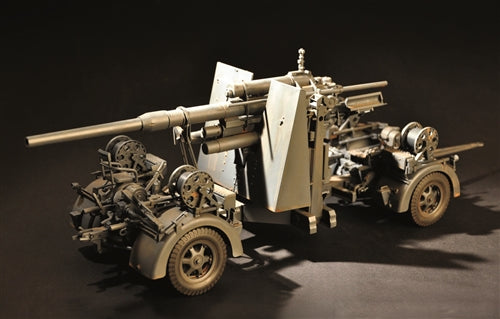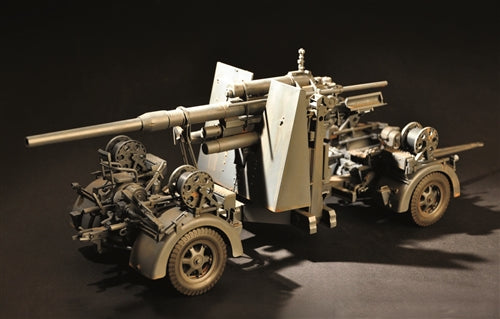I Love Kit 1/18 FlaK 36 88mm German Anti-Aircraft Gun 61701
I Love Kit 1/18 FlaK 36 88mm German Anti-Aircraft Gun 61701 will be backordered from our supplier. Delivery will take between 3-5 working days & orders will be despatched once completed.
Sign up to be the first to know when this product is back in stock!
Description
Description
Widespread production started with the Nazi rise to power in 1933, and the Flak 18 was available in small numbers when Germany intervened in the Spanish Civil War. It quickly proved to be the best anti-aircraft weapon then available.[citation needed] The flak detachment with 88s proved accurate and versatile in combat against mainly land targets, the high muzzle velocity and large caliber making it an excellent long-range anti-vehicle and anti-bunker weapon. This experience also demonstrated a number of minor problems and potential improvement opportunities.
The Flak 18's carriage allowed it to fire in an emergency when still on its wheels and without its outriggers, but with a very limited traverse and elevation.[4] For normal emplacement, one single-axle bogie was detached from the front outrigger and one from the rear, side outriggers were then hinged from the vertical position to the ground; the total time to set up was estimated at two and a half minutes.[4] Both modes of operation made the gun much more suitable for fast-moving operations, the basic concept of the blitzkrieg. The weight of the gun meant that only large vehicles could move it, the Sd.Kfz. 7 half-track becoming a common prime mover.
Targeting indicators were attached to the central controller to each of the four guns of a battery, allowing for coordinated fire. Indeed, with the automatic loading system, the gun layers' job was to keep the gun barrel trained on the target area based on the signals from the controller. The loaders would keep the weapon fed with live ammunition which would fire immediately upon insertion—all while the gun layer aimed the weapon according to the data.
North Africa, 8.8cm Flak 18 towed behind a Sd.Kfz. 7, with its side outriggers lifted for transport visible behind the gun shield
Many of these improvements were incorporated into the Flak 36, which had a two-piece barrel for easier replacement of worn liners. Flak 36s were often fitted with an armoured shield that provided limited protection for the gunners. These shields could be retro-fitted on older Flak 18s as well.
Specifications
Specifications
Payment & Security
Payment methods
Your payment information is processed securely. We do not store credit card details nor have access to your credit card information.


